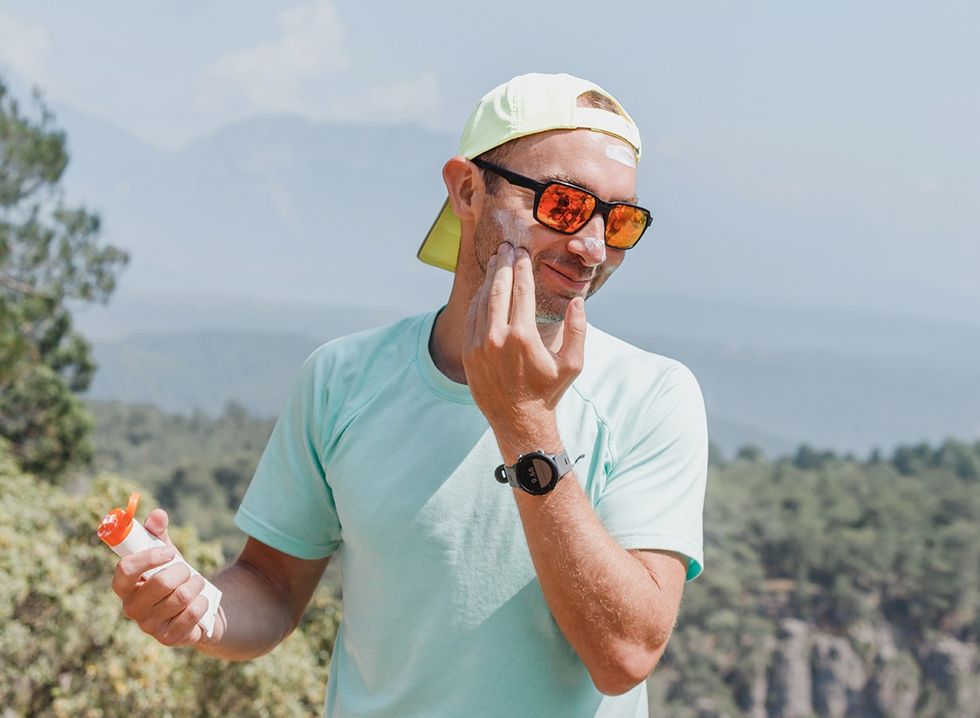If you’re one of the lucky ones who won’t get a cold, wet Memorial Day Weekend, your plans probably involve heading outside to soak in the sun—while slathering yourself in plenty of sunscreen, of course. But according to a scary new report, there’s only a 25 percent chance your sunscreen is safe and effective.
The Environmental Working Group (EWG) just released its annual report, which analyzed more than 2,204 sunscreens currently available for sale in the U.S.—only 498 of which were up to par. The report includes recreational sunscreens, baby and kids’ sunscreens, daily-use SPF, non-mineral sunscreens, and lip balms with SPF.
“Many sunscreens still fall short by offering misleading claims about protection, using outdated formulas, some even containing ingredients with potential health concerns,” states the report. “Federal sunscreen rules have remained largely unchanged since 1999, leaving consumers to navigate products with uncertainty.”
“Manufacturers continue to use ingredients the FDA has shown absorb through the skin and flagged for further assessment,” it continues. “Research links some of these chemicals to hormone disruption, yet companies have resisted investments in safety tests. Instead, they exploit regulatory gaps while keeping Americans in the dark about the potential risks of their products.”
With this in mind, read on to learn about how you can tell if your sunscreen is unsafe. Plus, get EWG’s list of the best sunscreens you can buy this year.
RELATED: 8 Best Mineral Sunscreens for Your Face, According to Dermatologists.
Mineral sunscreen vs. chemical sunscreen
Broad Spectrum SunscreenShutterstock
Before getting into the specifics of the report, it’s important to understand what makes today’s popular mineral sunscreens different from their counterparts.
“Mineral sunscreens act as a broad-spectrum protective film that reflects and deflects rays away from the skin, physically blocking the sun,” Rachel Lozina, a master esthetician, oncology esthetician, and the founder of Blue Water Spa, previously explained to Best Life. “It acts instantaneously and has less known topical side effects such as eczema, dermatitis, and atopic dermatitis.”
Zinc oxide and titanium dioxide are the two main ingredients in mineral sunscreens, “the only active sunscreen filters generally recognized as safe and effective by the FDA,” notes the EWG.
Chemical sunscreens, on the other hand, “are designed to soak into the skin as a chemical reaction absorbs ultraviolet radiation as energy and disperses it as heat,” explains CNN.
Research has shown that many of these chemicals are absorbed into the bloodstream, however, the EWG notes that two of the most harmful have dramatically declined in use.
For example, in 2016, 70 percent of non-mineral sunscreens contained oxybenzone, which is used to absorb UV radiation. After studies showed that oxybenzone can disrupt the hormone system and harm aquatic and marine ecosystems, only 9 percent of today’s non-mineral sunscreens contain it.
Likewise, the addition of vitamin A to non-mineral sunscreens has dropped from 41 percent of products in 2010 to just 2 percent today.
“Research has shown that vitamin A can degrade in sunlight, potentially accelerating rather than preventing skin damage,” states the EWG.
RELATED: Dermatologists Share the Best Drugstore Skincare Products: “Anything More Is Not Necessary.”
The top sunscreen risks
Shutterstock
When shopping for a safe and effective sunscreen, understanding the label is key. According to the EWG’s report, here are the top things to look out for:
Fragrance
According to the EWG, 36 percent of sunscreens contain ambiguous fragrance blends, “many of which may include allergens, hormone disruptors and even carcinogens.”
High SPFs
Generally, anything over SPF 50 does not provide additional coverage. “When used correctly, SPF 50 blocks about 98 percent of UVB rays, while SPF 100 blocks approximately 99 percent,” states the EWG. “Sunscreens with SPF values between 30 and 50 offer sufficient protection for most consumers when properly applied.”
Chemical “boosters”
Some mineral sunscreens rely on “boosters” to artificially raise the SPF number. “Using chemical boosters may result in a lower concentration of active mineral ingredients at the expenses of consumer safety,” David Andrews, acting chief science officer at the EWG, told CNN. A common booster, butyloctyl salicylate (BOS), absorbs UV rays similarly to chemical sunscreens, and is considered a possible reproductive and developmental toxicant by the European Union.
Inadequate UVA protection
The EWG explains that SPF is a good indicator of how well a sunscreen will protect against UVB rays, the primary cause of sunburn. However, this doesn’t take into account UVA rays, which cause long-term skin damage, wrinkles, and can lead to skin cancer. “On average, the UVA protection factor in these products was just a quarter of the labeled SPF value, which leads consumers to think they’re better protected than they are,” states the report.
Spray sunscreens
In 2019, the FDA proposed new testing guidelines for aerosol sunscreens, but they’ve yet to be finalized. “But the inhalation risk remains, and controversy lingers, especially after multiple recalls because of contamination by benzene, a known carcinogen detected in aerosolized sunscreens in 2021, 2022, and 2023,” points out the EWG.
RELATED: Dermatologist Shares the Biggest SPF Mistake You’re Making.
EWG’s top 10 sunscreens:
Solara; KORA Organics, Babo Botanicals, ATTITUDE
Excluding kids’ sunscreens and lip balms, these are the EWG’s top 10 most-recommended sunscreens:
- Solara Suncare: Glow Getter Nutrient Boosted Daily Sunscreen Lotion, Naturally Scented, SPF 30
- KORA Organics: Silky Sun Drops Mineral Sunscreen Serum, SPF 30
- Babo Botanicals: Sheer Zinc Mineral Sunscreen Lotion, SPF 30
- ATTITUDE: Sunly Mineral Sunscreen Lotion, Tropical, SPF 30
- Stream2Sea: Water Sport Sunscreen Lotion, SPF 30
- Well People: Bio Tint Tinted Moisturizer, 1C, SPF 30
- Well People: Bio Tint Tinted Moisturizer, 8N, SPF 30
- Well People: Daygleamer Mineral Sunscreen Serum,
- Babo Botanicals: Super Shield Sunscreen Lotion, SPF 50SPF 34
- Love Sun Body: Glow Natural Daily Tinted Mineral Face Sunscreen & Moisturizer Lotion, Sand, SPF 30
The best kids’ sunscreens and lip balms:
iStock
For babies and kids, these are the EWG’s five top picks:
- Thinksport: Clear Zinc Sunscreen Lotion, Kids, SPF 30
- Mustela: Mineral Sunscreen Stick, Face and Body, SPF 50
- ATTITUDE: Mineral Sunscreen Stick, Kids, Unscented, SPF 30 (old formulation)
- Happy Ocean: Mineral Sunscreen Lotion, Kids, SPF 45
- ATTITUDE: Mineral Sunscreen Stick, Kids, Face, Unscented, SPF 30 (old formulation)
Only four lip balms with SPF passed the EWG’s test:
- ATTITUDE: Sunly Lip Balm, Coconut, SPF 15
- ATTITUDE: Lip Balm, Coconut, SPF 15 (old formulation)
- Solara Suncare: Pout Protector Moisturizing Lip Serum, SPF 15
- ATTITUDE: Sunly Lip Balm, Unscented, SPF 15
Content shared from bestlifeonline.com.




